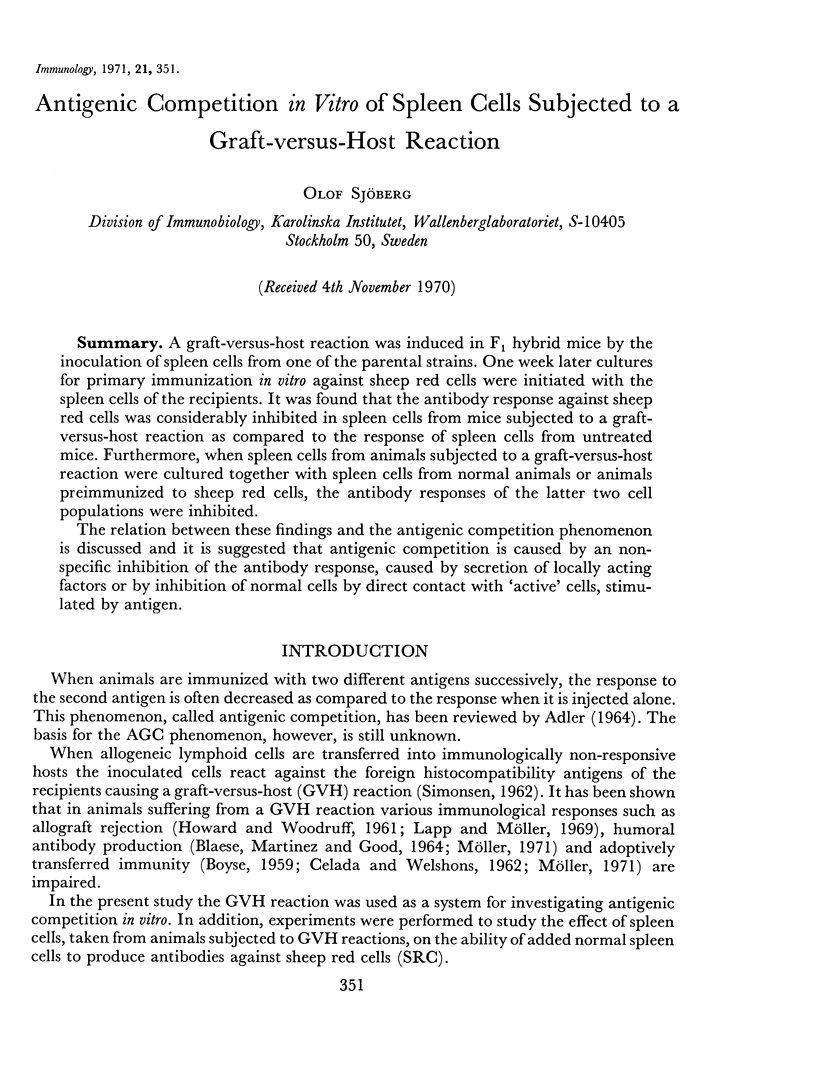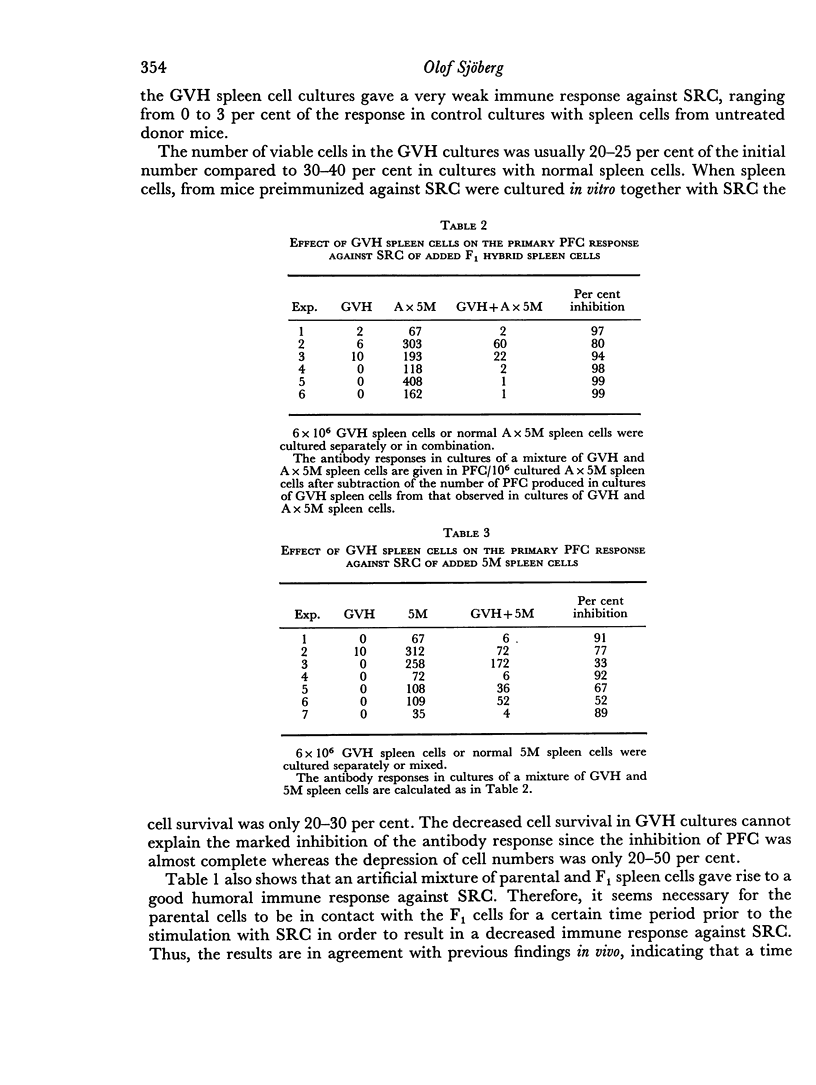Abstract
A graft-versus-host reaction was induced in F1 hybrid mice by the inoculation of spleen cells from one of the parental strains. One week later cultures for primary immunization in vitro against sheep red cells were initiated with the spleen cells of the recipients. It was found that the antibody response against sheep red cells was considerably inhibited in spleen cells from mice subjected to a graft-versus-host reaction as compared to the response of spleen cells from untreated mice. Furthermore, when spleen cells from animals subjected to a graft-versus-host reaction were cultured together with spleen cells from normal animals or animals preimmunized to sheep red cells, the antibody responses of the latter two cell populations were inhibited.
The relation between these findings and the antigenic competition phenomenon is discussed and it is suggested that antigenic competition is caused by an non-specific inhibition of the antibody response, caused by secretion of locally acting factors or by inhibition of normal cells by direct contact with `active' cells, stimulated by antigen.
Full text
PDF










Selected References
These references are in PubMed. This may not be the complete list of references from this article.
- BLAESE R. M., MARTINEZ C., GOOD R. A. IMMUNOLOGIC INCOMPETENCE OF IMMUNOLOGICALLY RUNTED ANIMALS. J Exp Med. 1964 Feb 1;119:211–224. doi: 10.1084/jem.119.2.211. [DOI] [PMC free article] [PubMed] [Google Scholar]
- BOYSE E. A. The fate of mouse spleen cells transplanted into homologous and F1 hybrid hosts. Immunology. 1959 Apr;2(2):170–181. [PMC free article] [PubMed] [Google Scholar]
- Brody N. I., Siskind G. W. Studies on antigenic competition. J Exp Med. 1969 Oct 1;130(4):821–832. doi: 10.1084/jem.130.4.821. [DOI] [PMC free article] [PubMed] [Google Scholar]
- CELADA F., WELSHONS W. J. Demonstration of F1 hybrid anti-parent immunological reaction. Proc Natl Acad Sci U S A. 1962 Mar 15;48:326–331. doi: 10.1073/pnas.48.3.326. [DOI] [PMC free article] [PubMed] [Google Scholar]
- Diener E., Shortman K., Russell P. Induction of immunity and tolerance in vitro in the absence of phagocytic cells. Nature. 1970 Feb 21;225(5234):731–732. doi: 10.1038/225731a0. [DOI] [PubMed] [Google Scholar]
- Dresser D. W., Wortis D. H. Use of an antiglobulin serum to detect cells producing antibody with low haemolytic efficiency. Nature. 1965 Nov 27;208(5013):859–861. doi: 10.1038/208859a0. [DOI] [PubMed] [Google Scholar]
- GORER P. A., BOYSE E. A. Pathological changes in F1 hybrid mice following transplantation of spleen cells from donors of the parental strains. Immunology. 1959 Apr;2(2):182–193. [PMC free article] [PubMed] [Google Scholar]
- JERNE N. K., NORDIN A. A. Plaque formation in agar by single antibody-producing cells. Science. 1963 Apr 26;140(3565):405–405. [PubMed] [Google Scholar]
- Lapp W. S., Möller G. Prolonged survival of H-2 incompatible skin allografts on F1 animals treated with parental lymphoid cells. Immunology. 1969 Sep;17(3):339–344. [PMC free article] [PubMed] [Google Scholar]
- Mishell R. I., Dutton R. W. Immunization of dissociated spleen cell cultures from normal mice. J Exp Med. 1967 Sep 1;126(3):423–442. doi: 10.1084/jem.126.3.423. [DOI] [PMC free article] [PubMed] [Google Scholar]
- Mosier D. E. A requirement for two cell types for antibody formation in vitro. Science. 1967 Dec 22;158(3808):1573–1575. doi: 10.1126/science.158.3808.1573. [DOI] [PubMed] [Google Scholar]
- Möller G. Regulation of cellular antibody synthesis. Cellular 7S production and longevity of 7S antigen-sensitive cells in the absence of antibody feedback. J Exp Med. 1968 Feb 1;127(2):291–306. doi: 10.1084/jem.127.2.291. [DOI] [PMC free article] [PubMed] [Google Scholar]
- Möller G., Sjöberg O. Effect of antigenic competition on antigen-sensitive cells and on adoptively transferred immunocompetent cells. Cell Immunol. 1970 May;1(1):110–121. doi: 10.1016/0008-8749(70)90064-x. [DOI] [PubMed] [Google Scholar]
- Möller G. Suppressive effect of graft versus host reactions on the immune response to heterologous red cells. Immunology. 1971 Apr;20(4):597–609. [PMC free article] [PubMed] [Google Scholar]
- Pierce C. W. Immune responses in vitro. I. Cellular requirements for the immune response by nonprimed and primed spleen cells in vitro. J Exp Med. 1969 Aug 1;130(2):345–364. doi: 10.1084/jem.130.2.345. [DOI] [PMC free article] [PubMed] [Google Scholar]
- Radovich J., Talmage D. W. Antigenic competition: cellular or humoral. Science. 1967 Oct 27;158(3800):512–514. doi: 10.1126/science.158.3800.512. [DOI] [PubMed] [Google Scholar]
- SIMONSEN M. Graft versus host reactions. Their natural history, and applicability as tools of research. Prog Allergy. 1962;6:349–467. [PubMed] [Google Scholar]
- Siskind G. W., Dunn P., Walker J. G. Studies on the control of antibody synthesis. II. Effect of antigen dose and of suppression by passive antibody on the affinity of antibody synthesized. J Exp Med. 1968 Jan 1;127(1):55–66. doi: 10.1084/jem.127.1.55. [DOI] [PMC free article] [PubMed] [Google Scholar]
- Theis G. A., Siskind G. W. Selection of cell populations in induction of tolerance: affinity of antibody formed in partially tolerant rabbits. J Immunol. 1968 Jan;100(1):138–141. [PubMed] [Google Scholar]


